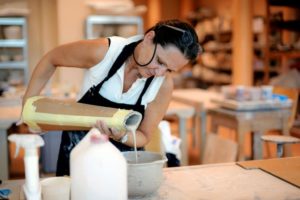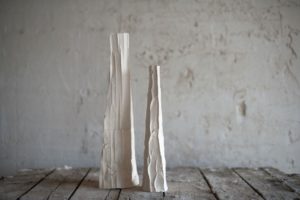On February 2018 I’ve received an invitation from the AICC, the Italian Association of Ceramic Cities, to participate at the 54th International Ceramic Sculpture Symposium in Boleslawiec, Poland, from August 4 to 26, and although I could only partially participate, I went to present my experimental project I called Lightness Technique, because I use cardboard molds that I model and cut to create the shapes of the vases and of the recent female sculptures that I’m making and that talk about the great heart of women. It is a search for lightness, both of material and technical path.

Pouring paperclay
I like the simplicity and sustainability of the materials I use, such as the paperclay, although often the difficulty lies in finding the simplest things.
Boleslawiec is a small town with about 40,000 inhabitants located in the southwest of Poland, in the Lower Silesian Voivodeship, on the border with Germany. It seems a little Prague. It has a tradition of producing artisanal ceramics dating back to the Middle Ages. The historic center is a jewel of restored buildings, with pastel colors, well cared for. At the Open Air Festival of ceramics, from 17 to 19 August, the central streets are enriched by wooden houses for the sale of artisanal ceramics, the producers are predominantly Polish but also German and Czechoslovaks.
The day of my arrival in Boleslawiec Mr. Mateusz Grobelny, the commissioner and organizer of the Symposium, welcomes me. He is a fine sculptor ceramist, able to realize monumental works, with him we exchanged mail when I wanted to understand if and how it was possible to work on my technique. The day of my arrival he brings me at the headquarters of the Ceramic Center, the International Boleslawiec Cultural Center (BOK-MC) close to the Central Square, here I’ll spend ten days working on my project. In the Centra Square, in a few days it will take place the spectacular firing night with the-dragon kiln.

Preparing the opera
The ceramic classrooms are on the second floor of a building that houses on the ground floor a typical artisan Boleslawiec ceramic shop, an Art Gallery, a Restaurant bar, create through a twinship with young Danes in a typical Northern Europe style.
Mateusz tells me that they make a good coffee, but as we wanted to demonstrate the concept of good coffee for us Italians is very different … however I’ll adapt…I’am not in Italy!. The ceramic center is well equipped, two classrooms with large windows, central tables, shelves, plaster molds of different workmanship and size, available to the participants, some wheels, many hand tools, extruder, kneader, 7/8 different types of beautiful refractory clays and the most interesting thing for me, white slip ready for the casting that I will use for my paperclay. In an other room the electric kiln with colors and glazes and a cabin with an airbrush. A separate classroom, also used for creative courses with children, has a smaller kiln for rehearsals and that’s where lunch is served every day at 2pm… more or less! There I meet Ruty Benjamin, an Israeli ceramist who lives and works in London, with whom I immediately become acquainted also because she has almost my age and Sarban Chowdhury, young talented Indian, of the age of my son. Sarban speaks a fast English with a strong Indian accent and, despite having worked abroad with Indians, I often struggle to understand.
At the Symposium we were 12 participants, 4 foreigners and the others Polish; some resident and some expatriates in several countries such as England, Norway and Australia. In Boleslawiec there are three large manufactures located just on the edge of the center whose ceramics are for the most part destined to a foreign market, European and Eastern, Korea, China. Even though centuries have passed, the technique of production has not changed much. Despite some minor changes in the production process, the crockery has been painted by hand or by the “stamp” method. Some of us, according to the type of work they had to perform, were assigned by the Symposium organizers to work in the Factories, others, like me, worked at the BOK-MCC, the Ceramics Studio. Some started with a well defined project, others took inspiration from the materials and equipment they found there, with excellent results.

The cartoon mold
The day of my arrival Mateusz told me that I should run my lecture at 6 pm, at the BOK-MCC, before his presentation about the Sympsoium History. Fortunately I had with me my usb drive and the documents related to the presentation.
I decided not to go back to the hotel both for the distance and for the semi-tropical clime that did not give up for almost the entire period of the Symposium.
Still a bit ‘dazed I followed he indication of Mateusz, on a map, to reach breathless BOK-MCC where I discovered that the audience is mainly composed of photographers gathered for the Symposium of Photography that takes place from 12 to 16 August. When there they told me that my presentation will be translated both into Polish and Czech so I had to summarized as much as possible to allow enough time to Mateusz to illustrates the history of the Symposium with related images of the staggering fireworks performed since 2013. The next day I start to work at the studio where some national television comes to record the workshop activities.
In the afternoon Mateusz invites us to go to watch the sunset, in a truly evocative and little known place, the kaolin quarry. A 20-minute drive from Boleslawiec, surrounded by forests, on a promontory, white sand dunes, at the foot of a lake. The quarry is artificial, but not less spectacular. The day ends with this unexpected immersion in the nature, while creating a bit ‘of anxiety for the time taken away from work, especially for those who started complex works. Who makes pottery knows that the processing steps are long and do not allow so many distractions.

Opening the mold
The following day we are literally assaulted by photographers of the Symposium, curious and interested in the various stages of our works, while they keep shooting and smile. We pass around our addresses in the hope of receiving some interesting pictures.
Meanwhile, the city is preparing for the opening of the 54th Boleslavian Ceramic Festival with lots of carnival parades , a mega funfair has already opened its doors and is perhaps the cause of the blackout that leaves half the town without energy for 4/5 hours, will be given back at midnight, in the meantime they created in Bursa, the convent that hosts us, moment of aggregation between the participants to the Symposium .
In serious difficulty to reach my room, and especially for the absence of internet, I am kindly provided by a nun of a Christmas light. In any case, I decide not to go into the room in the dark and I am delayed to make conversation with the husband of Aneta, if nothing else I speak a bit of English. The next day, at the Gallery of the BOK MCC, is inaugurated an exhibition of ceramics created by young women designers who work for the main local manufacturers .
Katarzyna, the official journalist of the Symposium, comes to the studio and starts interviewing us, reached by the “official” Photographer, a young Polish man who loves Italy. Meanwhile, we are preparing the kiln in the square for the following day filling it with pieces worked in the previous days.
In the afternoon the exhibition of participants in the 53rd and 54th Symposium opens, in Town Hall, with our opera that we brought in, respectively from each of our country. In the evening there will be a buffet in the Wedding Palace, whose rooms are on the ground floor, the most interesting room has intertwined vaults, very special that are recalled as a decorative solution to the Royal Hall of Vladislav Hall in Prague. It is also the official start day of the ceramics festival, with the carnival and the parade. Allegorical floats, parade in the square in front of Town Hall crowded with people, music and dancing, continues the tradition of sprinkling with clay. At 2 am the dragon kiln will be fired, on the esplanade in front of the church, not far away. It will be spectacular.

Done!
The following day, the touring exhibition opens in the Museum of History and Ceramics, Grand Tour, with a selection of traditional taste ceramics, chosen from the collection representatives of AICC. We all work hard to finish the pieces that need to be ready for the final exhibition on the 25th, but you can not avoid to visit the Ceramiki Muzeum, built in the early 1900s, which houses both contemporary ceramics and collections partly from donations from the 15th, 16th, 17th centuries.
The anxiety of the final fires rises because ceramics always reserve the surprise of the final cooking like unexpected cracks, fractures, for the firing of biscuits, unexpected effects of glazes in the second fire that is done here at high temperature.
The Symposium concludes with the official closing of the Open Air Exhibition at the BOK-MCC Studio Gallery with a general satisfaction of the results and with the regret of never having been able to visit more. Of not having made a swim in the pool or a jump at the public thermal baths, right in the center of the city.
Next time.
